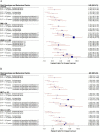Pro-inflammatory cytokine polymorphisms and interactions with dietary alcohol and estrogen, risk factors for invasive breast cancer using a post genome-wide analysis for gene-gene and gene-lifestyle interaction
- PMID: 33441805
- PMCID: PMC7807068
- DOI: 10.1038/s41598-020-80197-1
Pro-inflammatory cytokine polymorphisms and interactions with dietary alcohol and estrogen, risk factors for invasive breast cancer using a post genome-wide analysis for gene-gene and gene-lifestyle interaction
Abstract
Molecular and genetic immune-related pathways connected to breast cancer and lifestyles in postmenopausal women are not fully characterized. In this study, we explored the role of pro-inflammatory cytokines such as C-reactive protein (CRP) and interleukin-6 (IL-6) in those pathways at the genome-wide level. With single-nucleotide polymorphisms (SNPs) in the biomarkers and lifestyles together, we further constructed risk profiles to improve predictability for breast cancer. Our earlier genome-wide association gene-environment interaction study used large cohort data from the Women's Health Initiative Database for Genotypes and Phenotypes Study and identified 88 SNPs associated with CRP and IL-6. For this study, we added an additional 68 SNPs from previous GWA studies, and together with 48 selected lifestyles, evaluated for the association with breast cancer risk via a 2-stage multimodal random survival forest and generalized multifactor dimensionality reduction methods. Overall and in obesity strata (by body mass index, waist, waist-to-hip ratio, exercise, and dietary fat intake), we identified the most predictive genetic and lifestyle variables. Two SNPs (SALL1 rs10521222 and HLA-DQA1 rs9271608) and lifestyles, including alcohol intake, lifetime cumulative exposure to estrogen, and overall and visceral obesity, are the most common and strongest predictive markers for breast cancer across the analyses. The risk profile that combined those variables presented their synergistic effect on the increased breast cancer risk in a gene-lifestyle dose-dependent manner. Our study may contribute to improved predictability for breast cancer and suggest potential interventions for the women with the risk genotypes and lifestyles to reduce their breast cancer risk.
Conflict of interest statement
The authors declare no competing interests.
Figures



Similar articles
-
Pro-inflammatory cytokine polymorphisms in ONECUT2 and HNF4A and primary colorectal carcinoma: a post genome-wide gene-lifestyle interaction study.Am J Cancer Res. 2020 Sep 1;10(9):2955-2976. eCollection 2020. Am J Cancer Res. 2020. PMID: 33042629 Free PMC article.
-
Breast Cancer Risk and Insulin Resistance: Post Genome-Wide Gene-Environment Interaction Study Using a Random Survival Forest.Cancer Res. 2019 May 15;79(10):2784-2794. doi: 10.1158/0008-5472.CAN-18-3688. Epub 2019 Apr 1. Cancer Res. 2019. PMID: 30936085 Free PMC article.
-
Genome-wide Association Analysis of Proinflammatory Cytokines and Gene-lifestyle Interaction for Invasive Breast Cancer Risk: The WHI dbGaP Study.Cancer Prev Res (Phila). 2021 Jan;14(1):41-54. doi: 10.1158/1940-6207.CAPR-20-0256. Epub 2020 Sep 14. Cancer Prev Res (Phila). 2021. PMID: 32928877 Free PMC article.
-
Fat, caloric intake, and obesity: lifestyle risk factors for breast cancer.J Am Diet Assoc. 1997 Jul;97(7 Suppl):S24-30. doi: 10.1016/s0002-8223(97)00726-8. J Am Diet Assoc. 1997. PMID: 9216564 Review.
-
Breast Cancer and Menopausal Hormone Therapy by Race/Ethnicity and Body Mass Index.J Natl Cancer Inst. 2015 Nov 5;108(2):djv327. doi: 10.1093/jnci/djv327. Print 2016 Feb. J Natl Cancer Inst. 2015. PMID: 26546117 Free PMC article. Review.
Cited by
-
Involvement of INF-γ functional single nucleotide polymorphism +874 T/A (rs2430561) in breast cancer risk.Saudi J Biol Sci. 2021 Nov;28(11):6289-6296. doi: 10.1016/j.sjbs.2021.06.083. Epub 2021 Jul 2. Saudi J Biol Sci. 2021. PMID: 34759748 Free PMC article.
-
Non-linear relationship between the dietary inflammatory index and stroke risk in metabolically healthy obese individuals: an analysis of NHANES 1999-2023 data.Front Nutr. 2025 Jul 4;12:1608603. doi: 10.3389/fnut.2025.1608603. eCollection 2025. Front Nutr. 2025. PMID: 40686813 Free PMC article.
-
CRP and HNF1A collaborate to regulate the progression of laryngeal cancer through the Wnt signaling pathway.Funct Integr Genomics. 2025 Jul 25;25(1):160. doi: 10.1007/s10142-025-01670-6. Funct Integr Genomics. 2025. PMID: 40715562 Free PMC article.
-
Iridoid Derivatives as Anticancer Agents: An Updated Review from 1970-2022.Cancers (Basel). 2023 Jan 26;15(3):770. doi: 10.3390/cancers15030770. Cancers (Basel). 2023. PMID: 36765728 Free PMC article. Review.
-
HLA-DQA1 expression is associated with prognosis and predictable with radiomics in breast cancer.Radiat Oncol. 2023 Jul 11;18(1):117. doi: 10.1186/s13014-023-02314-4. Radiat Oncol. 2023. PMID: 37434241 Free PMC article.
References
Publication types
MeSH terms
Substances
Grants and funding
- HHSN268201100001I/HL/NHLBI NIH HHS/United States
- HHSN268201100004I/HL/NHLBI NIH HHS/United States
- HHSN268201100046C/HL/NHLBI NIH HHS/United States
- HHSN268201100003C/WH/WHI NIH HHS/United States
- HHSN271201100004C/AG/NIA NIH HHS/United States
- HHSN268201100002I/HL/NHLBI NIH HHS/United States
- HHSN268201100001C/WH/WHI NIH HHS/United States
- HHSN268201100004C/WH/WHI NIH HHS/United States
- HHSN268201100002C/WH/WHI NIH HHS/United States
- P50 CA211015/CA/NCI NIH HHS/United States
- K01 NR017852/NR/NINR NIH HHS/United States
- HHSN268201100003I/HL/NHLBI NIH HHS/United States
LinkOut - more resources
Full Text Sources
Other Literature Sources
Medical
Research Materials
Miscellaneous

